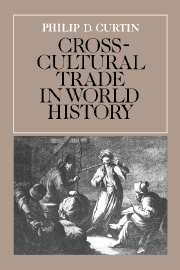Book contents
- Frontmatter
- Contents
- List of illustrations
- Preface
- 1 Trade diasporas and cross-cultural trade
- 2 Africa: incentives to trade, patterns of competition
- 3 Africa: traders and trade communities
- 4 Ancient trade
- 5 A new trade axis: the Mediterranean to China, circa 200 B.C. – A.D. 1000
- 6 Asian trade in Eastern seas, 1000–1500
- 7 The European entry into the trade of maritime Asia
- 8 Bugis, banians, and Chinese: Asian traders in the era of the great companies
- 9 Overland trade of the seventeenth century: Armenian carriers between Europe and East Asia
- 10 The North American fur trade
- 11 The twilight of the trade diasporas
- Bibliography
- Index
11 - The twilight of the trade diasporas
Published online by Cambridge University Press: 15 March 2010
- Frontmatter
- Contents
- List of illustrations
- Preface
- 1 Trade diasporas and cross-cultural trade
- 2 Africa: incentives to trade, patterns of competition
- 3 Africa: traders and trade communities
- 4 Ancient trade
- 5 A new trade axis: the Mediterranean to China, circa 200 B.C. – A.D. 1000
- 6 Asian trade in Eastern seas, 1000–1500
- 7 The European entry into the trade of maritime Asia
- 8 Bugis, banians, and Chinese: Asian traders in the era of the great companies
- 9 Overland trade of the seventeenth century: Armenian carriers between Europe and East Asia
- 10 The North American fur trade
- 11 The twilight of the trade diasporas
- Bibliography
- Index
Summary
It is often said that trade diasporas tended to work themselves out of existence, as commercial ties reduced the cultural differences that called them into being in the first place. But the Westernization of world commerce between about 1740 and 1860 was something new. It not only deprived the existing Western trade diasporas of an effective role; it ended once and for all the long era in history when trade diasporas had been the dominant institutional form in cross-cultural trade.
Industrialism and the shifting balance
The root cause of all this was not just the long-term trend toward more and larger areas of ecumenical trade; it was even more the birth of the industrial age. The new technology made possible a fundamentally new kind of human society, with much higher levels of production and consumption than ever before – but bringing with it new problems, environmental pollution, pressure on nonrenewable resources, weapons powerful enough to wipe out most of the human race.
In the first instance, the new industrial age was also the “European age,” if only because the Europeans got the new technology first, and with it the ability to conquer and dominate others at comparatively small cost. The balance of military power had begun to shift somewhat earlier. The “gunpowder empires” of the sixteenth century were a general Afro-Eurasian phenomenon.
- Type
- Chapter
- Information
- Cross-Cultural Trade in World History , pp. 230 - 254Publisher: Cambridge University PressPrint publication year: 1984



